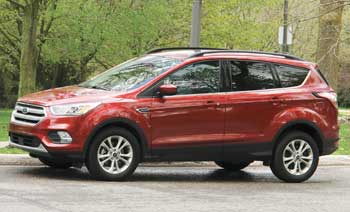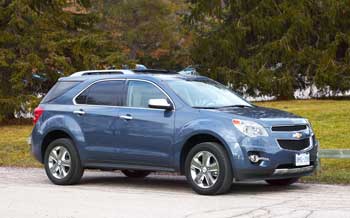Subaru Forester 2003-2008: pros and cons, problems
By Vlad Samarin Updated: January 02, 2024
No other SUV can compete with the Forester when it comes to a comfortable ride, fuel economy and excellent visibility. The Forester offers a 4-cylinder horizontally-opposed 'boxer' engine and standard all-wheel drive.
The Subaru all-wheel drive system is one of the best. The 2003-2008 Forester received 5-star ratings in the NHTSA crash tests. The interior is simple and functional. Front seats are supportive and comfortable on long trips. The optional sunroof is huge. Available front and rear wiper deicers along with heated seats and mirrors are a big plus for winter conditions. Is the Forester reliable? What are the pros and cons and common problems?
Pros:
- All-Wheel Drive (AWD): The 2003-2008 Forester comes with standard AWD, which is proven to be one of the best.
- Spacious Interior and Visibility: The Forester offers a roomy and versatile interior, with ample cargo space and comfortable seating and good visibility.
- Ground Clearance: It has a higher ground clearance compared to traditional sedans, making it more suitable for snow and light off-roading.
- Relatively Affordable: Compared to some other SUVs in its class, the 2003-2008 Forester is not very expensive.
Cons:
- Head Gasket Issues: One common problem reported in this generation of Forester is head gasket failure. This can lead to coolant leaks and overheating. The repair is not cheap.
- Timing Belt Replacement: The Forester's timing belt needs to be replaced around the 105,000-mile mark, which is also costly.
- Aging Components: As these vehicles age, various components like suspension parts, wheel bearings, engine seals, and gaskets may deteriorate, leading to increased maintenance costs.
- Fuel Efficiency: The fuel efficiency of the Forester from this era may not be as competitive compared to newer models in the same class.
- Rust Issues: In regions with harsh winters and road salt, these models are prone to rust, particularly on the undercarriage and wheel arches.
2003-2008 Subaru Forester Problems:
Oil leaks from seals and gaskets are common. An oil pressure switch/sensor is another common source of the oil leak. If a large amount of oil leaks out, the engine can get damaged from running low on oil. This means, check the oil level regularly and top up as needed. Repair options depend on the source of the leak. Some seals and gaskets are often replaced when changing the timing belt.The head gasket replacement is costly (10.1 hours of labor for both sides, non-turbo engine), however, many wear parts (seals, gaskets, timing and drive belts, water pump, ignition wires etc.) are typically replaced at the same time. If needed, the cylinder heads can also be rebuilt at the same time.
It is a big job, but if it's done right, it's like a second life for the engine. It's even possible to replace the head gaskets without removing the engine, so it might be a good DIY project for mechanically inclined Subaru owners. We found this great video describing the head gasket replacement on the EJ253 engine.
Misfiring is a common issue on both engines. Sometimes it could be caused by fouled/worn spark plugs or old spark plug wires. The ignition coil pack can corrode/crack too. Symptoms include shaking, lack of power and the Check Engine light on. Depending on the results of diagnosis, spark plugs, wires and other parts may need to be replaced.
Failed catalytic converters have been reported by many owners. Typically a failed catalytic converter causes the Check Engine light with the code P0420. Some owners mentioned that they opted for cheaper aftermarket parts that were fitted at a local muffler shop.
Advertisement
Loose exhaust heatshields can cause a rattling noise at certain rpms. The heatshields must be re-secured; it's an easy repair.
Wheel bearings: The main symptom of a bad wheel bearing is a humming noise that gets louder at highway speeds. Replacing the wheel bearing might require 2.5-3.0 hours of labor plus the part.
Subaru issued a few recalls; check at the NHTSA website.
Powertrain: The Forester offers two engines of the EJ25 family: the 173-hp 4-cylinder 2.5L SOHC and the turbo-charged 224-hp 2.5L DOHC. Both are flat Boxer engines with cylinders arranged horizontally; two cylinders on each side. Both engines have a timing belt that must be replaced at recommended intervals. The turbo-charged DOHC engine requires premium gasoline. Read also: Pros and cons of turbo engines. The engine oil capacity is listed at 4.2 US qt (4.0 liters, 3.5 Imp qt). Transmission choices include a 5-speed manual with a Hill Holder clutch or a 4-speed automatic.
Summary: Is the 2003-2008 Forester a Good Car to Buy?
The reliability was OK for a while, but with age, failed catalytic converters, blown head gaskets, piston slap and other problems started to show up. At higher mileage, the engine noises, misfiring and various leaks are often reported. If you are a DIY person and don't mind to get your hands dirty, you will always have something to do with this car. It's a one great project.As of January 2022, Consumer reports rates the overall reliability of the 2004 and 2005 Forester as 'average', other model years of this generation are rated 'below average'.
On the plus side, the Forester has scored well in the crash tests. It offers great all-around visibility and decent towing capacity for a small SUV. The AWD system is good too. Features like built-in roof rails and wiper deicers can be helpful.
Related reviews:
Subaru Forester 2009-2013
Subaru Outback 2005-2009
Subaru Outback 2010-2014
Toyota Camry 2007-2011
Honda Accord 2008-2012
Toyota RAV4 2006-2012
Honda CR-V 2007-2011
Ford Escape 2008-2012
Jeep Patriot 2007-2017
What to look for when buying a used Subaru Forester: If the engine has been overheated in the past, avoid the car; overheating can cause many problems down the road. Watch out for oil and coolant leaks; the repair might be quite expensive. A burnt oil or coolant smell coming under the hood is an indication of leaks. For models with a manual transmission, test the clutch.
Watch out for a piston slap and other engine noises (tapping or knocking) when the car is started cold. Check if the timing belt has been replaced. If you notice blue smoke from exhaust, or from under the hood, especially when the engine is started, avoid the car. Read more: How to inspect a used car - illustrated guide. Have the vehicle inspected by a mechanic familiar with Subaru vehicles before signing a contract.
Fuel Economy: The 2008 AWD Forester with a non-turbo engine and automatic transmission is rated at 20/26 mpg (11.8/9.0 L/100 km) by the U.S. EPA. This means that on one full 16.9-gallon (64 liter) tank, the Forester can travel for 335 miles (538 km).
Handling and ride: On the road, the Forester is fun to drive. The flat horizontally placed engine gives the Forester a low center of gravity and as a result, the tall Forester feels very stable on winding roads. At the same time, the ground clearance is high enough not to worry about hitting curbs. Overall, handling is secure with minimal body roll, even in tight corners. The steering is on the light side, but precise, with a tight turning radius. The ride is smooth. There is some wind and road noise at higher speeds, but not too intrusive. The non-turbo 2.5L engine has enough power for everyday driving. A turbo-charged engine is quicker, but is more expensive to maintain.
AWD System: What makes Subaru special is its Symmetrical All-Wheel Drive where the left and right axles are of the same length. Models with a manual transmission have an AWD system with a central limited slip differential. In automatic models, the torque distribution is controlled electronically by a hydraulic transfer clutch.
 The Forester offers 64.5 cu. ft (1826 L) of cargo space
with the rear seats folded down
The Forester offers 64.5 cu. ft (1826 L) of cargo space
with the rear seats folded down  Subaru Forester 2.5-liter engine
Subaru Forester 2.5-liter engine A viscous limited-slip rear differential is available. Although the Forester's AWD system is not designed for rock climbing, it works well on slippery roads or in moderate off-road conditions. We drove the Forester through foot-deep snow and the vehicle handled with confidence. Watch this video of the Forester in the deep snow.
Safety: Anti-lock Brakes (ABS) are standard. The 2003-2008 Subaru Forester received perfect five-star ratings in the NHTSA frontal and side-impact crash tests and four stars in dynamic rollover tests. The Forester also earned the 2008 Top Safety Pick award from IIHS.
Maintenance tips: Have your oil changed regularly, for the engine to last. A turbocharged engine is more sensitive to oil quality; use only good quality oil. Check your tire pressure regularly; unequal tire pressure will cause increased wear of the 4WD system components. Overheating the engine may cause expensive damage; check the coolant (antifreeze) level and top up if it's low. Subaru recommends using a special cooling system conditioner whenever the coolant is changed, check with your Subaru dealer.



